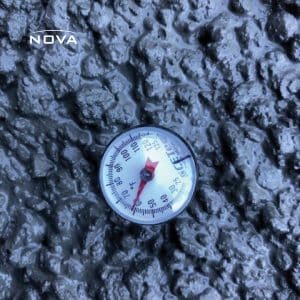 December 6, 2022
December 6, 2022
Think this image contains a batch of candy cooking on the stove? The small coarse aggregates give the impression of a material similar to fudge or another sweet treat being prepped. Hungry to find the answer? Read on to discover what is actually cooking. . .
In reality, this image has captured a concrete temperature measurement for a 5,000 Pounds per Square Inch (PSI) air-entrained mix used in the repair of a parking deck. The black mark on the thermometer indicates it is 1 of 2 thermometers calibrated at the same time for record keeping. While in some cases concrete temperatures typically encountered may suffice, for hot and cold concrete placements, the acceptable concrete temperature values are important to meet minimum or maximum temperature requirements. NOVA’s certified inspectors and technicians always measure these three items in the concrete mix when preparing samples for compressive strength testing: percentage of air content, slump (which means consistency or workability), and temperature (both the air ambient temperature and the concrete temperature). The mix design and the project specifications will define the specified in ranges for any given mix to be acceptable for placement, ensuring a higher likelihood of yielding the desired final compressive strength, workability, and durability of the properties.
Many crucial observations are involved when testing concrete during cold and hot weather. The temperature measurement is important during cold weather concreting to ensure that the concrete is warm enough to begin to react, set, and develop strength. The current American Concrete Institute (ACI) definition of cold weather concreting is defined as, “when air temperature has fallen to, or is expected to fall below 40 °F during the protection period.” The protection period is defined as the time recommended to prevent concrete from being adversely affected by exposure to cold weather during construction. Failure to follow these guidelines and requirements can potentially lead to problems with the freezing of concrete at an early age. While working with hot weather concrete placements, hot weather is defined as more than just air temperature. Hot weather is defined by ACI when, “one or a combination of the following conditions that tends to impair the quality of freshly mixed or hardened concrete by accelerating the rate of moisture loss and rate of cement hydration, or otherwise causing detrimental results: high ambient temperatures, high concrete temperatures, low relative humidity, and high wind speeds.” To avoid early hardening (“flash-setting”) and poor finishing conditions, ACI suggests limiting the maximum concrete temperature to 95 °F at the time of discharge. Stricker requirements are applicable for mass concrete placement, where due to the size and quantity of the placement, additional precautions may apply. NOVA’s inspectors and technicians provide a VALUABLE service by observing and monitoring temperature and fluctuations in temperature while also reporting potentially discrepant conditions. These observations can help avoid discrepancies and rework, which in turn can save our client’s’ time and money in the process.
Photo credit: Neil Fitzgibbons, Special Inspector

